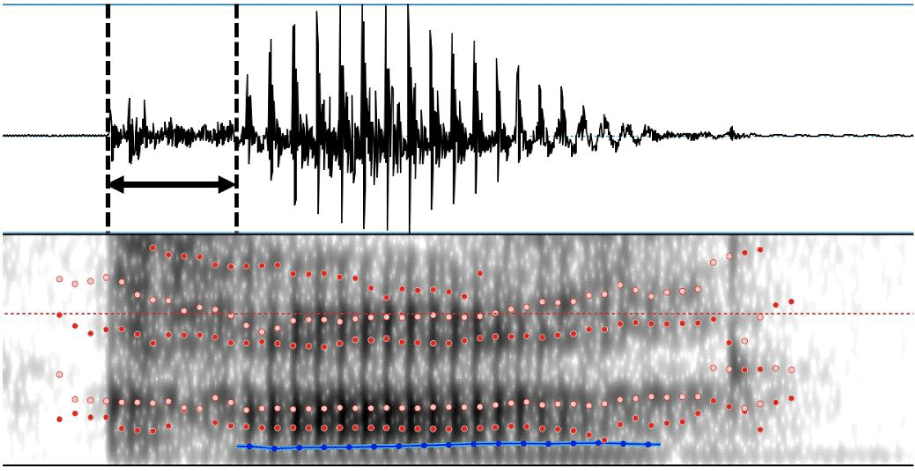1. Introduction
Voicing and aspiration are two common phonetic features that are often employed in a binary fashion for classifying stops across languages. Korean, however, has a three-way contrast of word- initial stops that are all voiceless, presenting a typologically unusual case for studying stop contrasts. These stops are often categorized as the lenis, the fortis, and the aspirated, which occur across three places of articulation–i.e., bilabial, denti-alveolar, and velar. In terms of laryngeal characteristics, these stops are assumed to be contrastive as follows: lenis stops are breathy and slightly aspirated, fortis stops are tensed, laryngealized, and unaspirated, and aspirated stops are strongly aspirated (e.g., Cho et al., 2002). Traditionally, the three- way contrast was considered to be reflected in a distinction in voice onset time (VOT), which may refer to the timing between the supralaryngeal release gesture and the laryngeal voicing gesture (cf. Ladefoged & Cho, 2001). The VOT would be longest for the aspirated, shortest for the fortis, and intermediate for the lenis stops, although VOT ranges may overlap quite substantially between the lenis and the aspirated stops (cf. Cho, 1996; Cho et al., 2002). [Note that the classification of stops is traditionally defined along the two phonetic dimensions of voicing and aspiration (e.g., Lisker & Abramson, 1964)]. More recent studies, however, have revealed that the VOT distinction between the lenis and aspirated stops has been disappearing, causing a VOT merger for these two stop categories (e.g., Bang et al., 2018; Choi et al., 2020; Kim, 2013; Silva, 2006). Additionally, it has been proposed that females are more likely to exhibit the VOT merger than males in Seoul Korean (e.g., Kang, 2014).
It has been also reported that the aerodynamic and physiological factors that contribute to differences in VOT are related to the velocity of articulatory movements and the temporal relationship between the stop closure and VOT (Cho & Ladefoged, 1999). Maddieson (1997) states that there is a trade-off between the closure duration and the following VOT during the constant movement cycle of abduction and adduction of the vocal cords. That is, a longer closure duration results in a shorter VOT and vice versa. Thus, fortis consonants, which have the shortest VOT, have the longest closure duration. Previous kinematic research supported the relationship between closure duration and VOT with the fortis having the longest supralaryngeal closure duration as reflected in a binary distinction (/p/</ph, p*/) in lip constriction duration (e.g., Cho et al., 2016) and the three-way distinction in the tongue dorsum closure duration and in peak velocity of the tongue dorsum closing movement (/k/</kh/</k*/) (e.g., Brunner et al., 2011).
Cho et al. (2016) also discovered the three-way contrast in a kinematic study of labials in lip constriction degree (/p/</ph/</p*) in IP-initial and IP-medial positions. The results showed that the three-way contrast becomes more pronounced as the constriction advances, suggesting that the contrast increases with progression. The three-way contrast was also found in deceleration duration of the tongue dorsum closure movement (/k*/</kh/</k/) (Brunner et al., 2011). These studies support the perspective of the virtual target hypothesis, which posits that different target positions can be defined virtually, even beyond the physical limitations of the palate, resulting in varying closure durations.
The kinematic studies mentioned above provide evidence for the three-way stop contrast in Korean being distinctive at both laryngeal and supralaryngeal levels. However, these studies had a limited number of participants [three speakers for Brunner et al. (2011) and five speakers for Cho et al. (2016)], making it difficult to generalize the findings to the larger population. Further studies with larger sample sizes and varied demographics would be needed to establish the validity and generalizability of these findings.
In addition, recent studies suggest that the distinction between lenis and aspirated stops in Seoul Korean has shifted from a difference in VOT to a difference in F0, particularly among younger speakers. This indicates that the traditional understanding of the three-way stop contrast based solely on VOT has changed, incorporating multiple acoustic and phonetic factors. Given that the kinematic studies were conducted several years ago and the VOT merger sound change appears to have been underway, a significant question arises regarding whether and to what extent the kinematic properties of the three-way stop contrast may have changed, potentially reflecting the effects of the sound change on supralaryngeal articulation. The position of the tongue during VOT might be adjusted based on the articulatory closure duration, which tends to be inversely proportional to VOT when VOT is defined in terms of articulation (as in Cho & Ladefoged, 1999), as pointed out by Maddieson (1997). In the case of the lenis-aspirated distinction, if the VOT values for these sounds become similar, it would indicate that the differential hold duration-related impacts on articulation may no longer exist. In other words, the three-way supralaryngeal distinction, which were previously present, would be also lost along with the VOT merger.
Considering these possibilities, the present study measured VOT and kinematic realization of the three-way laryngeal contrast of velar stops at the onset of monosyllabic structures produced by twenty-two young Seoul Korean speakers to examine the impact of the recent VOT merger between the lenis and aspirated stops on the supralaryngeal differences between the two sounds, and how the results of the kinematic analysis may be interpreted in light of this merger. It will also be investigated if the distinction between the lenis and aspirated stops at the supralaryngeal level, particularly the loss of the distinction, is more noticeable in female speech as the ongoing sound change is believed to be led by female speakers.
2. Methods
Twenty-two Seoul and Gyeonggi speakers in their 20s took part in the experiment as part of a project aimed at building an articulatory and acoustic database for Korean at Hanyang Institute for Phonetics and Cognitive Science of Language (HIPCS, 2022). The HIPCS data corpus was designed to build articulatory and acoustic corpus of major Korean dialects. The corpus currently contains recordings from 26 speakers of Seoul Korean. Speakers read 7 short paragraphs in two or three different speech rates and produced 25 sets of monosyllables and 4 sets of disyllables. As a part of the corpus data collection, the participants were instructed to produce eighteen /Ca/ syllables with varying consonants. The three-way contrastive velar stops of /ka/, /kha/, and /k*a/ were selected for investigation in this study. We chose /Ca/ syllables because the low-vowel /a/ context creates a notable vertical movement from the velar to the following vowel, and it also allows us to observe the tongue dorsum movement with a minimal overlap with the possible palate contact, which is likely to occur in a high vowel context. We investigated these velar stops in the word-initial or phrase initial position. A total of 132 tokens (3 velars×22 speakers×2 repetition) are included in this paper.
The acoustic data were obtained using a Tascam HC-P2 digital recorder and a SHURE KSN44 condenser microphone with a sampling rate of 44,010 Hz, along with the articulatory data collection using Electromagnetic Articulograph (EMA, AG501, Carstens Electronics). Eight movement sensors were placed on articulators to track the movement of articulators in real time 3D. Six movement sensors were positioned on the speech articulators: tongue dorsum (TD), tongue body, tongue tip, the lower lip and upper lip at the vermilion border, and the middle of the lower gumline. The nasion and upper incisor were used as fixed reference sensors. The data from TD sensor have been examined to track the closing and opening movement of tongue dorsum for velar closure.
For VOT measurements, the onset of stop burst and the start of vocal fold periodicity (voicing) of the subsequent vowel were manually identified. The duration between the beginning of the stop burst and the onset of vocal fold vibrations was taken as VOT, as depicted in Figure 1.
The analysis of kinematic data was carried out using Mview, a set of Matlab scripts created by Mark Tiede at Haskins Labs. The diagram in Figure 2 illustrates the kinematic measurements and relevant landmarks for the closing and opening movement trajectory and the tangential velocity of the tongue dorsum.
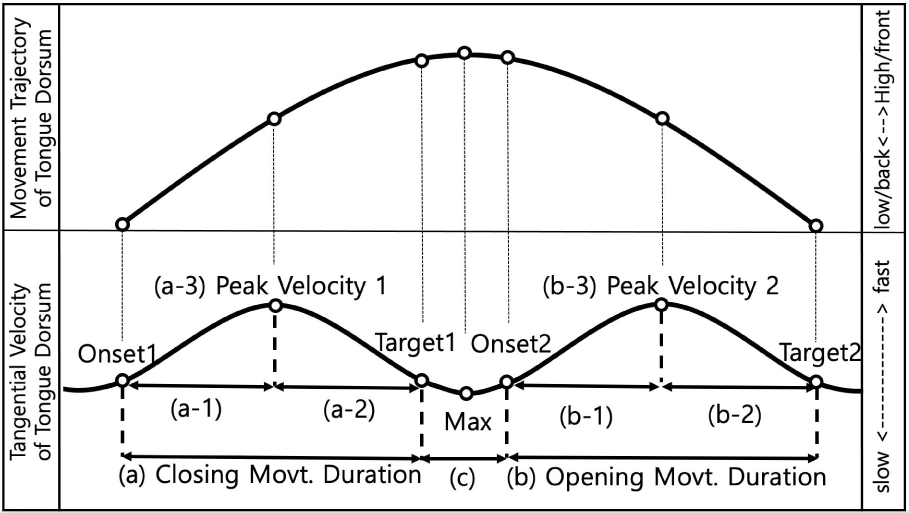
The kinematic measurements taken for the study are illustrated in Figure 2. For the tongue dorsum closing movement for the velar stops (a), we measured (a-1) Acceleration Duration 1: duration from Onset 1 to Peak Velocity 1, (a-2) Deceleration Duration 1: from Peak Velocity 1 to Target 1, and (a-3) Peak Velocity 1. For the tongue dorsum C-to-V opening movement (b), we measured (b-1) Acceleration Duration 2: from Onset 2 to Peak Velocity 2, (b-2) Deceleration Duration 2: from Peak Velocity 2 to Target 2, and (b-3) Peak Velocity 2. We measured supralaryngeal constriction duration as marked in (c) Closure Duration: from Target 1 to Onset 2. In addition, forward and vertical movement duration from Onset 1 to Target 1 was measured.
For statistical analyses, Consonant (lenis, aspirated and fortis) and Gender (male and female) were employed as fixed factors and Speaker as a random effect in both acoustic and articulatory measurements. The effect of Gender and Consonant on the VOT and the articulatory gestures of the velar stops was examined, based on linear mixed-effects models (LMMs) using the lmer() package (Bates et al., 2015) followed by the post hoc Tukey test via the emmeans() (Lenth, 2022) package in the statistical programming language R (R core team, 2021).
Since the present study explored the gender difference in both acoustic and articulatory measurements, we performed post-hoc pairwise comparison tests (using Tukey correction) of the Consonant effect for the two gender groups, even when there were no significant interactions from the linear-mixed effects models.
3. Results
LMM was created to examine the effect of gender and consonant on VOT with the reference levels of Gender “female” and Consonant “kh” as follows: VOT~gender*consonant+(1+gender | speaker). Their mean values and standard deviations are given in Table 1.
| VOT (ms) | |||
|---|---|---|---|
| k | kh | k* | |
| Female | 86.42 (17.55) | 83.17 (18.80) | 23.60 (8.77) |
| Male | 87.10 (19.95) | 103.04 (19.77) | 22.24 (6.27) |
There were significant main effects of Consonant and Gender such that males tended to show longer VOT values than females (β=19.87, SE=5.66, p<0.01) and the fortis stop is more likely to show shorter VOT than the aspirated stop (β=–59.57, SE=4.02, p<0.001). There were also significant interactions between Gender and Consonant, which is due to the fact that male speakers showed a three-way distinction while female speakers did not.
The results of post-hoc pairwise comparisons indicated that females produced the aspirated stop with shorter VOT values than males (β=–19.87, SE=7.23, p<0.05). Males showed longer VOT for the aspirated stop than the lenis stop (β=15.95, SE=3.92, p<0.001) while females did not show the difference. VOT was shorter for the fortis than the lenis stops in both females (β=–62.8, SE=5.3, p<0.001) and males (β=–64.9, SE=5.3, p<0.001); and it was shorter for the fortis stop than the aspirated stops in both females (β=59.57, SE=5.47, p<0.001) and males (β=80.8, SE=5.47, p<0.001). These patterns are illustrated in Figure 3.
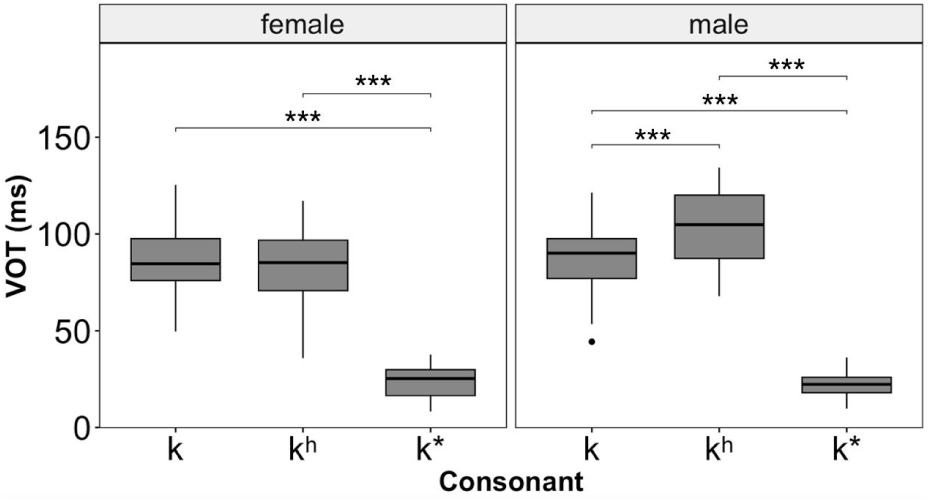
LMM was created to examine the effect of gender and consonant on articulatory movements with the reference levels of Gender “female” and Consonant “kh” as follows: (i) Closure Duration~ gender*consonant+(1 | speaker), (ii) Peak Velocity 2~gender* consonant+(1+gender | speaker), (iii) Deceleration Duration 2~ gender*consonant+(1+gender | speaker), (iv) Opening Movement Duration 2~gender*consonant+(1+gender | speaker).
There was no significant effect of either Consonant or Gender on the during the TD closing movement. However, as will be explained in detail below, significant effects were found for closure duration, and also for peak velocity, deceleration duration, and the entire opening movement duration for the tongue dorsum C-to-V opening movement. The mean values and standard deviations for these effects are listed in Table 2.
Closure Duration showed a significant effect of Consonant (β=39.57, SE=11.06, p<0.001). There was no significant effect of Gender nor a significant interaction between Consonant and Gender. Post-hoc comparisons were further performed, as one of our goals was to see the gender difference in the stop production. Results showed that for female speakers, the fortis stop had a significantly longer closure duration than the lenis stop (β=44.1, SE=10.9, p<0.001) and the aspirated stop (β=–39.6, SE=15.8, p<0.05) although there was no significant difference between the lenis and aspirated stops (/k/, /kh/</k*/). For male speakers, the fortis stop displayed a significantly longer closure duration than the lenis stop (β=–33.3, SE=10.9, p<0.01), but there was no significant difference between the aspirated and fortis stops nor between the lenis and aspirated stops (/k/</k*/). The patterns are depicted in Figure 4.
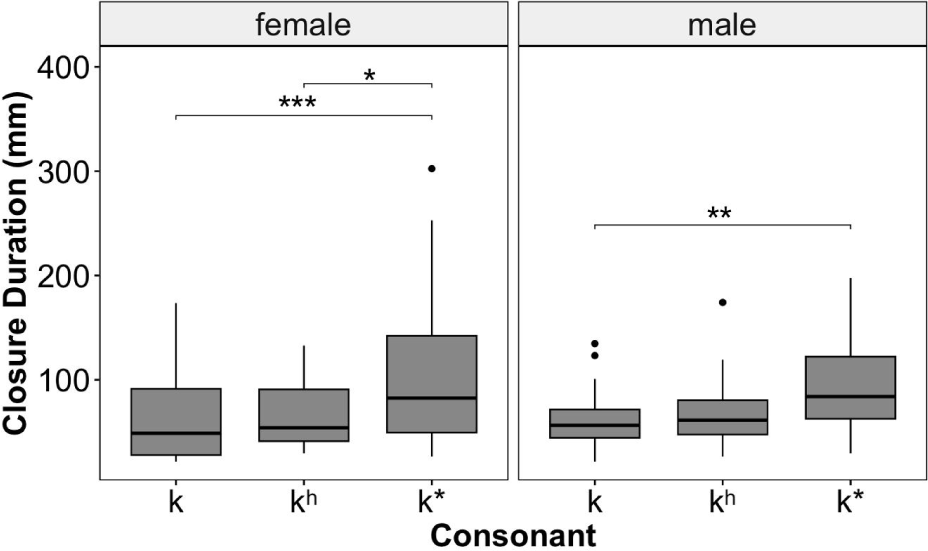
Peak Velocity of the tongue dorsum C-to-V opening movement (i.e., Peak Velocity 2) showed main effects of Consonant (β=2.67, SE=0.76, p<0.001) and Gender (β=3.73, SE=1.40, p<0.05), such that the fortis stop showed significantly higher peak velocity than the aspirated stop and males showed significantly higher peak velocity than females. There was also an interaction between Consonant and Gender (β=2.39, SE=1.08, p<0.05) (Figure 5).
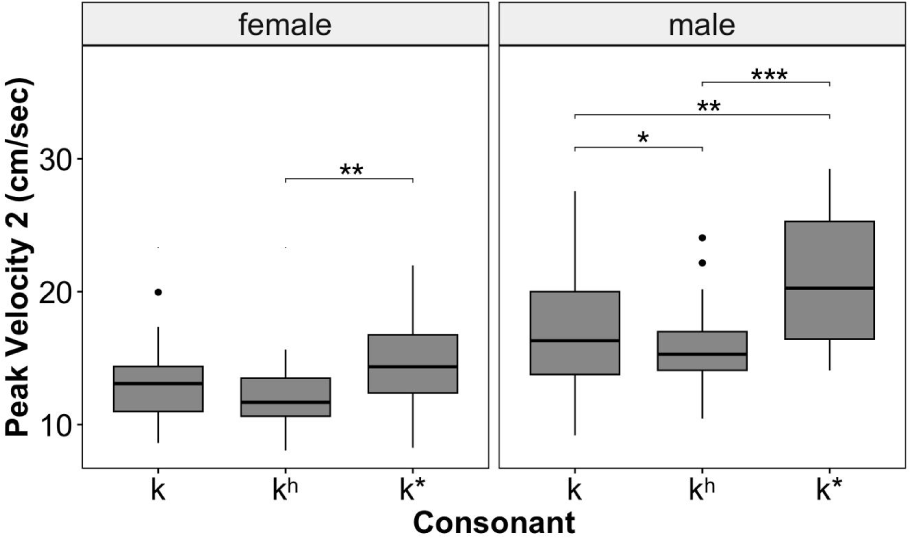
Additional post-hoc comparisons showed that only male speakers made a three-way distinction in terms of peak velocity during the opening movement, as in Figure 5. The lenis stop showed a significantly higher peak velocity than the aspirated stop (β=–2.01, SE=0.73, p<0.05), and the fortis stop shows significantly higher peak velocity than the lenis stop (β=3.05, SE=0.95, p<0.01) and the aspirated stop (β=–5.06, SE=0.87, p<0.001). In contrast, female speakers only showed a significantly higher peak velocity for the fortis than for the aspirated stops (β=–2.67, SE=0.87, p<0.01).
The Deceleration Duration of the TD opening movement (i.e., Deceleration Duration 2) showed a main effect of Consonant: the lenis stop was articulated with significantly longer deceleration duration than the aspirated stop (β=20.28, SE=6.36, p<0.01). There was also an interaction between Consonant and Gender, such that the fortis stop was articulated with significantly shorter deceleration duration than the aspirated stop, which was only found with the male speakers (β=–20, SE=8.99, p<0.05).
Follow-up post-hoc comparisons revealed that both males and females showed a two-way distinction yet in different ways, as shown in Figure 6. The fortis stop was articulated with significantly shorter deceleration duration than the lenis stop in both females (β=–21.2, SE=6.2, p<0.01) and males (β=–30.5, SE=6.2, p<0.001). However, the aspirated stop was articulated with significantly shorter deceleration duration than the lenis stop only in females (β=–20.3, SE=6.95, p<0.01); and the aspirated stop was produced with significantly longer deceleration duration than the fortis stop only in males (β=21.42, SE=6.35, p<0.01).
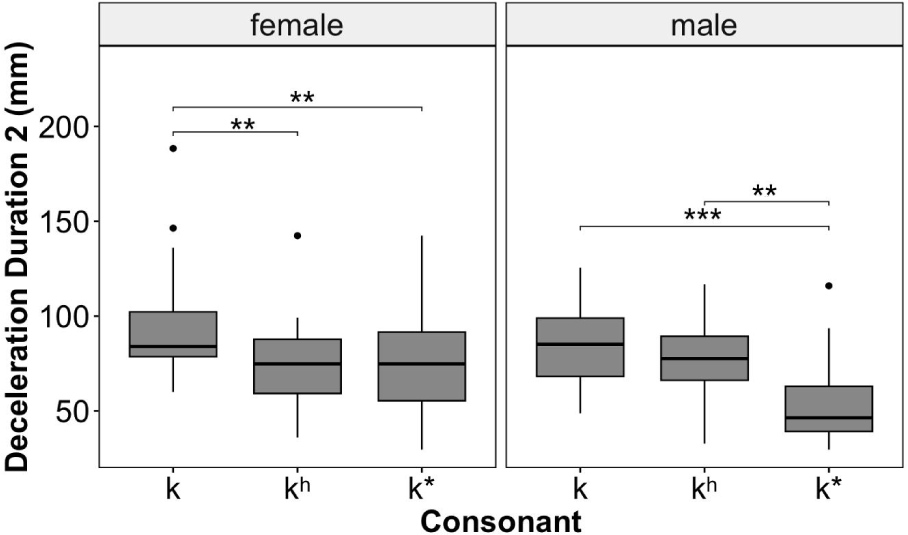
As for the entire Opening Movement Duration, the main effects of Consonant and Gender were not significant, but there was a trend effect of Consonant, such that the lenis stop was produced with longer opening movement duration than the aspirated stop (β=17.66, SE=9.12, p=0.056). The interaction effect of Consonant and Gender was significant (β=–31.48, SE=12.90, p<0.05) (Figure 7).
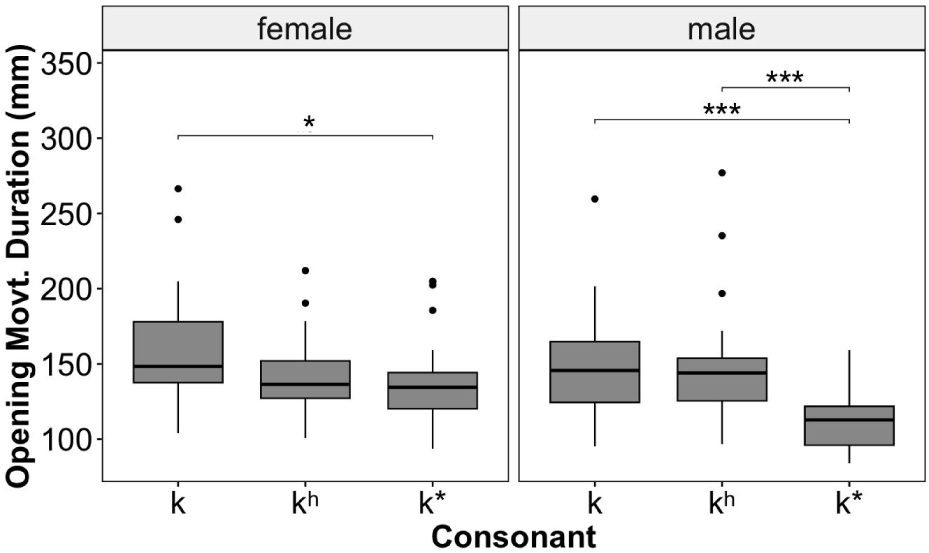
Subsequent post-hoc comparisons revealed that the fortis stop showed significantly shorter opening movement duration than the lenis stop in both females (β=–21.6, SE=8.69, p<0.05) and males (β=–36.7, SE=8.69, p<0.001), but that the aspirated stop showed longer opening movement duration than the fortis stop only in males (β=35.39, SE=8.68, p<0.001), as in Figure 7.
Finally, there was no significant result observed in the vertical and forward movements.
4. Summary and Conclusion
To summarize, the results of VOT in the present study showed that the lenis-aspirated contrast is lost in females (/kh/=/k/>/k*/) while the three-way contrast still remains in males (/kh/>/k/>/k*/).
As for the kinematic measurements, the distinctions among the velar stops were found during the velar closure and the tongue dorsum opening movement, but not during the tongue dorsum closing movement.
The three-way contrast was observed in the peak velocity during the tongue dorsum opening movement, but only for males (/kh/</k/</k*/). Female speakers showed a two-way distinction (/kh/</k*/).
For all the other kinematic measures, both groups showed a binary distinction albeit in different ways. In articulatory closure duration, it was found that females contrasted the fortis with the other two stops (/k/=/kh/</k*/), while males only showed a difference between the lenis and fortis stops (/k/</k*/).
As for the Deceleration Duration of the tongue dorsum opening movement, both groups showed shorter duration for the fortis than the lenis stops (/k*/</k/). However, they differed in terms of the deceleration duration between the aspirated and the fortis stops: Females showed no difference between the two stops (/k*/=/kh/</k/) whereas males showed a longer deceleration duration for the aspirated stops than the fortis stop (/k*/</k/=/kh/).
The findings from the TD Opening Movement Duration were similar to those of deceleration duration in that both groups showed a shorter opening movement duration for the fortis than the lenis stop (/k*/</k/), but only the male speakers showed an additional durational difference between the fortis and the aspirated stops (/k*/</k/=/kh/).
The findings of the present study are in line with the previous observations of gender-based variations in VOT values of stops in Seoul Korean: the distinction between lenis and aspirated stops is not maintained in females (/kh/=/k/>/k*/) but it still exists in males (/kh/>/k/>/k*/), supporting the idea that the on-going language change in VOT is led by females (Bang et al., 2018).
Turning to the results of closure duration, the results appear to illustrate a trade-off between closure duration and the following VOT, in line with Maddieson (1997). That is, fortis stops with the shortest VOT were produced with the longest articulatory closure duration. It should also be noted that the lenis and the aspirated stops did not show any distinction in closure duration. This lack of distinction could also be related to the neutralization of the lenis-aspirated difference in terms of VOT. No differences in VOT could have affected the supralaryngeal articulation, resulting in no difference in the articulatory closure duration between the two stops.
An additional noteworthy discovery of this study is that a three-way distinction persisted in males in the peak velocity measure during the opening movement, showing the reverse order of the traditional three-way VOT contrast (/kh/</k/</k*/). The result, in general, seems to be in line with previous studies on the velar and bilabial stops (Brunner et al., 2011; Cho et al., 2016). Crucially, however, the current study showed that this three-way distinction was not present in females. This result also seems to indicate that males are more resistant to sound change than females not only in terms of the laryngeal contrast but also in supralaryngeal articulation.
It should be noted, however, that our results do not imply that any of the articulatory measures taken for the study would have a direct one to one mapping with their acoustic outcome, possibly with an exception of articulatory closure duration which is most directly relevant to an acoustic dimension (i.e., acoustic closure duration). Rather, it seems to be the case that speakers make articulatory efforts in various dimensions to achieve a synergistic articulatory goal for phonemic contrast, which eventually affect the acoustic output.
The findings of the study provide evidence of the loss of the supralaryngeal articulatory distinction between the lenis and aspirated velar stops, as well as the progression of a change in VOT. Further, the results also show that the disappearing lenis-aspirated kinematic distinction is also led by female speakers.
Finally, the kinematic data presented here are not representative for the three-way stop contrast system because the current study is limited to the velar stops produced in isolated monosyllabic structures. More studies on the relationship between kinematic characteristics and laryngeal contrast in various contexts are called for to enhance our understanding of how the sound change in the three-way stop contrast is reflected in the supralaryngeal articulation in Korean.








